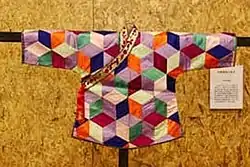| Baijiayi | |||||||
|---|---|---|---|---|---|---|---|
 A child's baijiayi. | |||||||
| Chinese name | |||||||
| Chinese | 百家衣 | ||||||
| Literal meaning | One-hundred family clothing | ||||||
| |||||||
| Baijiapao | |||||||
| Chinese | 百家袍 | ||||||
| Literal meaning | One-hundred families robe | ||||||
| |||||||
| English name | |||||||
| English | One hundred families robe/ Hundred-Families robe/ One hundred families clothing | ||||||
Baijiayi (Chinese: 百家衣; pinyin: bǎijiāyī), also known as baijiapao (Chinese: 百家袍; pinyin: bǎijiāpáo) and sometimes referred as One hundred families robe,[1] Hundred-Families robe,[2] or One hundred families clothing in English,[3] is a form of Chinese patchwork jacket, particular for male children.[4] The baijiayi is used as a protective talisman for children.[4][5][1][2] It is a traditional Han Chinese custom garment, which has been passed down for centuries.[4][1]
Cultural significance and symbolism
The baijiayi is a symbol of longevity, and it was one of the ritual procedures of the "One-hundred-day celebration", along with the baijia locks.[5] It is made of donated fabrics,[2] and is composed of one hundred pieces of fabric which could be shaped into tessellated squares, triangles, diamonds, rectangles, and hexagons.[4][1] It could also be embroidered with symbols and motifs which were considered auspicious, such as auspicious clouds, the Chinese zodiac, the bagua and the five poisons.[4][1]
In the past, due to the lag in health care and education, infant mortality was relatively high. Nevertheless, people believed that an infant's death was due to a ghost.[1] The baijiayi was supposed to protect the child from evil spirits through the use of many donated fabrics of multiple colours.[2][1] These small pieces of cloth was collected from various local families, which were supposed to represent " one hundred families".[5] These pieces of fabric would symbolize the combined strength of the donators and were believed protect their sons from or ward off evil spirits and ghosts.[1] The mother would receive these pieces of fabrics in order to make the finished baijiayi for her child.[4][1] The baijiayi could not be taken off until the child reaches one year old.[5]
History
Origins

People started making Chinese patchwork in the Liu Song of the Southern dynasty. The first emperor of Liu Song Dynasty, named Liu Yu, was born in an underprivileged family. His mother gathered rags from the neighbourhoods to make a patchwork cloth. When he became the emperor, he perceived this kind of patchwork as the symbol for his impoverished childhood. All the infants in Liu’s family had to use the patchwork so that his offspring could know how fortunate they were. Afterward, his citizens followed this royal custom of making "Bai jia yi" for their babies.[6]
Other version
A similar style of clothing to the baijiayi is the shuitianyi.[7]
Gallery
 Baijiayi
Baijiayi
See also
References
- 1 2 3 4 5 6 7 8 9 Hanson, Marin F. (2012). "Cross-cultural Commemoration:Historical Chinese Patchwork Inspires a New Tradition in America". Textile Society of America 13th Biennial Symposium. Washington, DC.
- 1 2 3 4 "Crazy Clothing Worldwide | World Quilts: The Crazy Quilt Story". worldquilts.quiltstudy.org. Retrieved 2021-04-16.
- ↑ "Quilts of Southwest China | International Quilt Museum - Lincoln, NE". www.internationalquiltmuseum.org. Retrieved 2021-04-19.
- 1 2 3 4 5 6 Hanson, Marin, F. (2014). "'One Hundred Good Wishes Quilts': Expressions of Cross-Cultural Communication". Uncoverings: Research Papers of the American Quilt Study Group. 35 – via EBSCO Host.
{{cite journal}}: CS1 maint: multiple names: authors list (link) - 1 2 3 4 Feng, Ge (2015). Traditional Chinese rites and rituals. Zhengming Du. Newcastle upon Tyne: Cambridge Scholars Publishing. pp. 45–46. ISBN 1-4438-8783-8. OCLC 935642485.
- ↑ Aqiusha (2012). "百家衣的由來 (Origin of Baijia yi)". Archived from the original on November 18, 2015. Retrieved February 11, 2015.
- ↑ Yin, Zhihong (2019). "Study on the Evolution and Development of Baina Clothing to Shuitian Clothing in the Ming and Qing Dynasties". Advances in Social Science, Education and Humanities Research. Atlantis Press. 368: 315–318. doi:10.2991/icassee-19.2019.65. ISBN 978-94-6252-837-6.